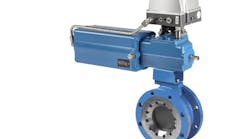Proper valve and piping material handling begins with knowing the proper tools to use and how to use them. Wrenches are important tools on piping jobs, but improper use can cause considerable damage. Choose the right type and size to avoid job delay.
Wrench examples
- Hex and monkey — Size zero square jaw wrenches that turn smoothly are best for hex end valves and fittings. They fit better on the part to be turned and do not have the crushing effect of a pipe wrench. Because of the jaw shape, hex or monkey wrenches cannot be used on pipes or other round objects.
- Pipe tongs or chain — Used for larger pipe sizes, (3 inches and up), but they are available for smaller sizes.
- Strap — Used mainly when working with plated or polished materials to avoid marring the surface. They are useful for tight places that are difficult to reach with pipe wrenches.
- Pipe — Designed for use on pipe- and screwed-end fittings. They are less efficient than monkey wrenches on hex ends. The tightening of this wrench could damage valve ends.
- Open end — Most suitable for valve maintenance and can be worked with quickly. The right size helps avoid wrench slippage, which could cause bruised knuckles and can wear the nut and bolt heads round.
- Pipe vise — Used for pipe only. A combination vise with square and gripper jaws is suitable for other work including pipe. Experienced piping workers never excessively squeeze the part or pipe or force the working valve parts of out of line.
Overall, avoid bearing down on the joint with an oversize wrench or a wrench with an extension handle. It often results in more leverage than necessary and may result in pulling up a joint so tightly that the fitting will be cracked, the valve will twist out of shape or the pipe will run clearly into the seats.
Always put a wrench on the end of the valve or fitting being made up. This gives better leverage and prevents the possibility of twisting an unsupported valve body or damaging its working parts.
One should use copper or lead covers on vise jaws when holding a valve for repair work to prevent damage to finished surfaces. Valves should be placed in vise with valve ends — not the valve sides between the jaws as a precaution against damaging the valve body.
Valve installation measures
Foreign matter will create an operational issue. To avoid this, protectors should be put on valve ends at the manufacturing plant as the valve is prepared for shipment. The protectors should not be removed until the valve is installed. Storing piping materials properly will pay dividends after installation.
It is good practice to prevent breakdowns caused by the presence of sand, dirt and scale that may settle in the pipe when it is stored in a pipe yard prior to installation. Common methods to remove dirt include thorough swabbing the pipe or using blowing it out with compressed air. It is good practice to open all valves fully to flush or blow out dirt. This removes any loose scale, foreign matter, dust, dirt, etc.
When threaded ends are damaged, avoid taking chances with the joint. If the end is badly damaged, cut it off and rethread it. Usually the damage can be repaired by running a die over the threads to clean up and straighten them. Damaged threads can usually be repaired by screwing a tap into them.
A small investment in time and preventive maintenance on the front end could save a lot of money on the back end.
Handling
If a valve will not operate easily, do not apply brute force. Putting a wrench, steel bar or a hammer on a wheel for extra leverage may damage the valve. To close a valve properly, bring the disc to its seat gently, back it off a turn and repeat two or three times. This action should flush away whatever foreign matter had lodged on the seat. If it does not, take the valve apart, inspect and clean it. Do not forget to hydro test per rating to design pressure prior to installation to check for all leaks (replace soft goods if damaged).
As important as it is to select the right valve for the application, it is also important that the right valve is installed in the right place, height or location to access the operation. One cannot expect a valve to contribute to the overall efficiency of a system if it is installed in a location that is difficult to access. Manual valves cannot be operated efficiently if an operator cannot reach the hand wheel. Abused valves will not operate efficiently. Do not expose them to damaging blows. A bent stem not only cripples a valve, but may cause a shutdown that results in costly operations delay and replacement or repair.
Preventive maintenance
To maintain the valve properly, the operator should implement a scheduled routine of sealant system top-offs with synthetic lubricant. Typically a new valve will require top-offs more often than a valve that has been in operation for years. It is during the first year of operation that the valve seals sit tightest against the ball, plug or gate and lubricant is required to reduce the breakout torque during operation. Top off the lubricant every time a valve is stroked for the first year in addition to a semiannual full-service schedule. It may seem excessive, but a small investment in time and preventive maintenance on the front end could save a lot of money on the back end when taking into account pipe section isolation during emergency shutdowns. Compared to the cost of an emergency valve body sealing job, a preventive maintenance routine will quickly pay for itself.
For example, if a leak occurs at the flange seal, retighten the cover nuts. If the leak is still present, install a new flange seal. To do this, reduce the valve pressure to zero.
If a leak is present at the stuffing box packing:
- For live-loaded valves — Recheck the calibration of the load cells in accordance with the manual instructions. If the leak continues, repack the valve by performing a shutdown.
- For valves without live-loading — Retighten the gland nuts. If the leak remains, repack the valve.
On suspicion that an internal leak exists or that the valve is not working properly, reduce the valve pressure to zero and allow the valve to reach ambient temperature. One or more of the following actions should then be taken:
- If possible, perform a thorough visual examination of the valve’s inside. Remove any foreign matter from the seating areas.
- Place the valve on a test stand and conduct testing to detect any inoperative features or leakage.
- Return the valve to the manufacturer or authorized repair shop for engineering, inspection, testing and any necessary repairs.
Remove the valve from the line and disassemble for inspection and necessary repairs.
For actuated valves, make sure before removing the valve from the line for testing or overhaul that the problem is not in the actuator or electrical connections.
Conclusion
Much of this information is not new, yet thousands of valves in the energy industry are scheduled for replacement each year, which causes lost production. One could almost eliminate valve replacement before their service life expectancy ends with a few simple steps. In combination with specialized sealants and pumping equipment, it is conceivable that any valve could stay in service indefinitely and retain sealing integrity.
Gobind Khiani is a professional engineer with more than 23 years of experience in the petroleum industry. He has a bachelor’s degree from the University of Pune in India and a master’s degree from the University of Calgary in materials and pipeline engineering. Khiani has served as lead engineer in engineering and project management roles for operating companies and engineering, procurement, and construction companies. During this time he has authored more than 225 publications and presentations in his field for magazines, journals and conferences. Over the past 4 years, Khiani has been a global piping valve subject matter expert in the Piping Department at Fluor.




